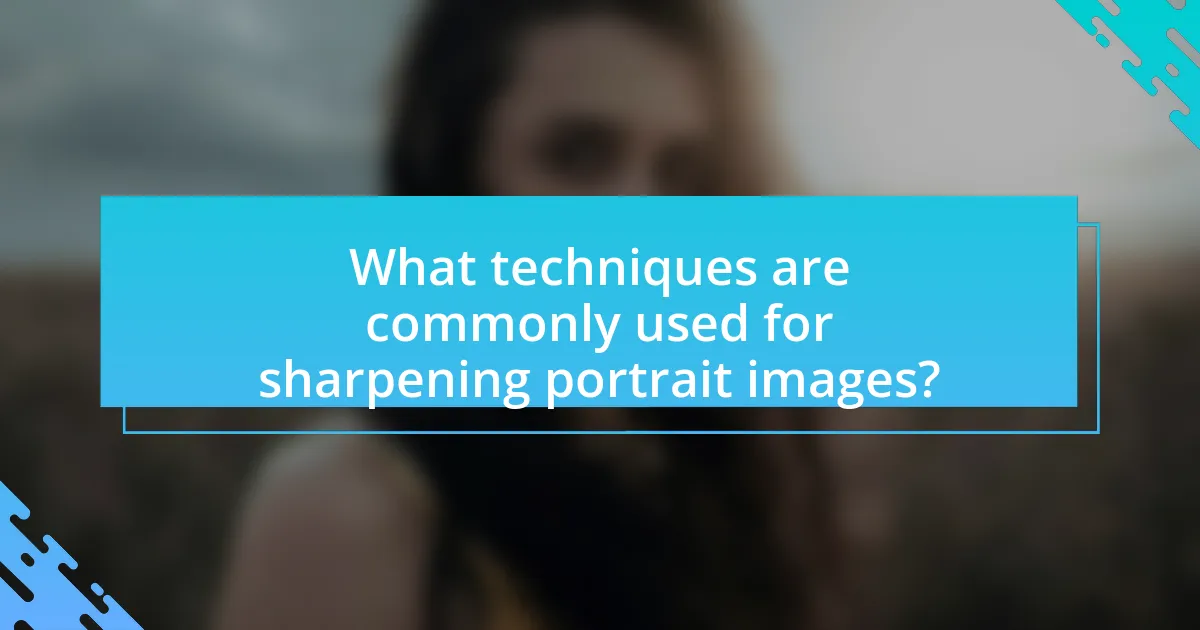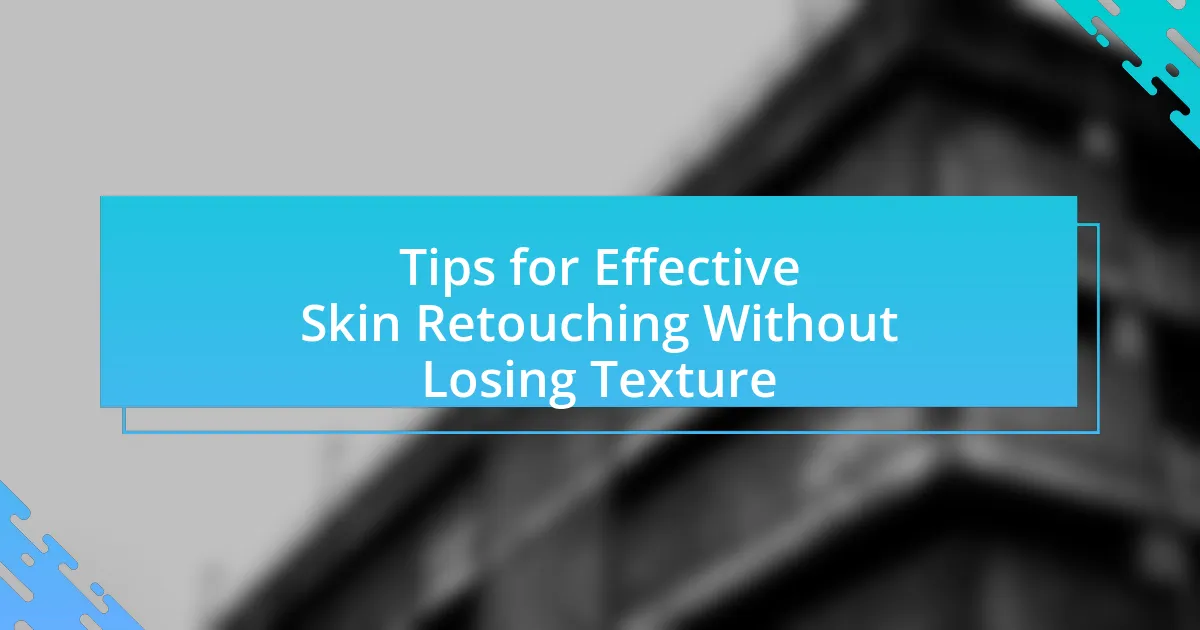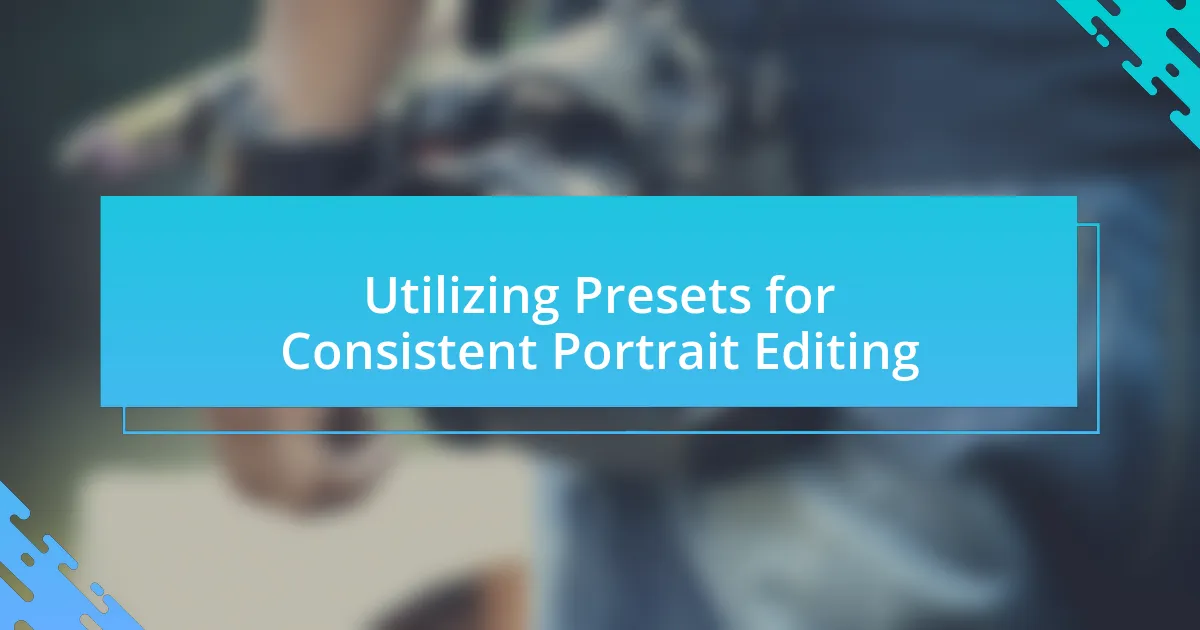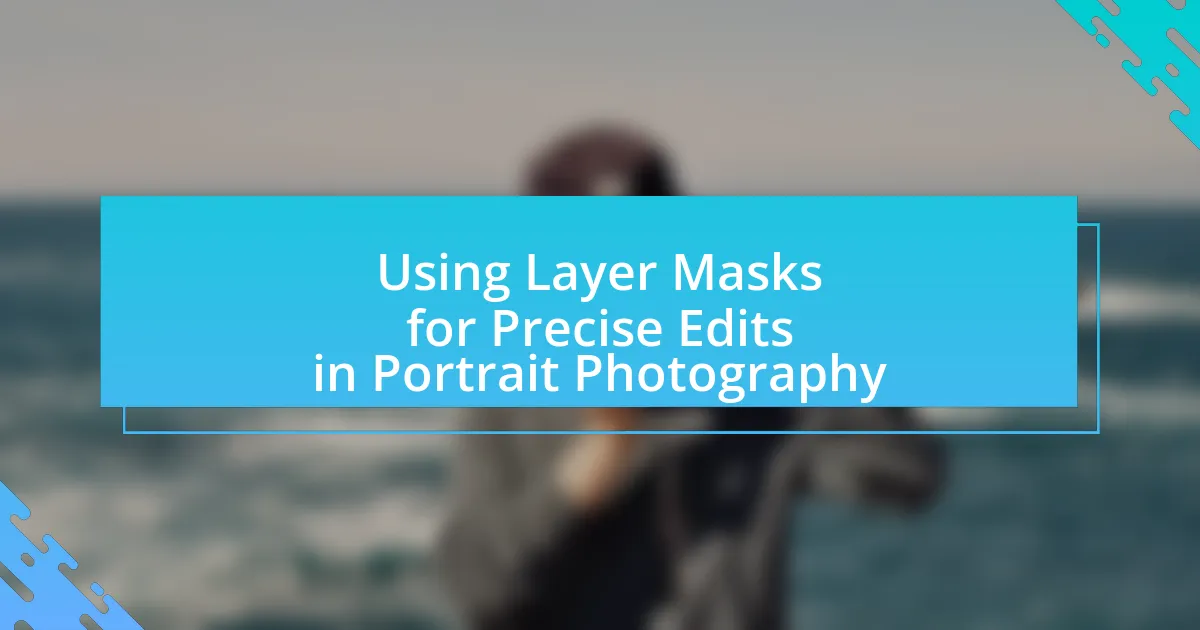The article focuses on the critical role of sharpening in finalizing portrait images, emphasizing how this process enhances clarity and detail, particularly in facial features. It discusses various sharpening techniques, including Unsharp Mask and High Pass Filter, and their effectiveness in improving perceived image quality without introducing noise. The article also highlights the importance of selective sharpening, best practices, and common mistakes to avoid, ensuring that portraits maintain a natural appearance while drawing attention to key features like eyes and hair. Additionally, it addresses the consequences of neglecting sharpening and provides practical tips for achieving optimal results in portrait editing.

What is the role of sharpening in finalizing portrait images?
Sharpening enhances the clarity and detail of portrait images, making facial features more defined and visually appealing. This process increases the contrast between adjacent pixels, which helps to emphasize textures such as skin, hair, and eyes. Research indicates that effective sharpening can significantly improve the perceived quality of an image, as it draws attention to important details while maintaining a natural appearance. For instance, studies in digital imaging have shown that properly applied sharpening can elevate the overall impact of a portrait, ensuring that it stands out in both print and digital formats.
How does sharpening enhance the details in portrait images?
Sharpening enhances the details in portrait images by increasing the contrast between adjacent pixels, which makes edges appear more defined and prominent. This process helps to accentuate features such as eyes, lips, and hair, resulting in a more visually striking and detailed representation of the subject. Studies in digital imaging have shown that effective sharpening can improve perceived detail without introducing significant noise, thereby maintaining the overall quality of the image.
What specific features of a portrait benefit from sharpening?
The specific features of a portrait that benefit from sharpening include the eyes, hair, and facial details. Sharpening enhances the clarity and definition of the eyes, making them more engaging and expressive, which is crucial in portrait photography. Additionally, sharpening the hair adds texture and detail, contributing to a more realistic appearance. Facial details, such as skin texture and features like lips and eyebrows, also gain definition through sharpening, improving the overall impact of the portrait. These enhancements are supported by the fact that well-defined features draw the viewer’s attention and create a more compelling image.
How does sharpening affect the overall perception of a portrait?
Sharpening enhances the overall perception of a portrait by increasing the clarity and detail of facial features, making the image appear more defined and visually appealing. This process emphasizes edges and textures, which can draw the viewer’s attention to important aspects of the subject, such as the eyes and skin texture. Research indicates that well-sharpened images are perceived as more professional and engaging, as they convey a sense of realism and depth. For instance, a study published in the Journal of Vision found that viewers rated sharper images higher in quality and emotional impact compared to softer images.
Why is sharpening considered a crucial step in portrait editing?
Sharpening is considered a crucial step in portrait editing because it enhances the clarity and detail of the subject’s features, making the image more visually appealing. This process improves the perception of sharpness, particularly in areas like the eyes and hair, which are focal points in portraits. Research indicates that well-sharpened images can significantly increase viewer engagement and emotional response, as detailed features contribute to a more lifelike representation. Therefore, effective sharpening techniques are essential for achieving professional-quality portraits that capture the subject’s essence.
What are the potential consequences of neglecting sharpening?
Neglecting sharpening in portrait images can lead to a loss of detail and clarity, resulting in images that appear soft or blurry. This lack of sharpness diminishes the overall quality of the portrait, making it less visually appealing and potentially unprofessional. Studies have shown that images with proper sharpening techniques can enhance perceived detail and improve viewer engagement, while those without sharpening often fail to capture attention effectively. Therefore, neglecting this crucial step can significantly impact the final presentation and reception of portrait images.
How does sharpening contribute to the final output quality of portraits?
Sharpening enhances the final output quality of portraits by increasing the clarity and definition of edges, which makes the subject appear more detailed and visually appealing. This process emphasizes fine details such as hair strands, eyes, and textures, contributing to a more lifelike representation. Research indicates that effective sharpening can improve perceived image quality, as it helps to counteract the softening effects that can occur during image capture and processing. For instance, a study published in the Journal of Imaging Science and Technology found that appropriate sharpening techniques significantly improved viewer perception of image sharpness and detail in portrait photography.

What techniques are commonly used for sharpening portrait images?
Common techniques for sharpening portrait images include Unsharp Masking, High Pass Filter, and Clarity adjustments. Unsharp Masking enhances edge contrast by increasing the difference between adjacent pixels, effectively sharpening the image. High Pass Filter works by isolating the high-frequency details in an image, allowing for targeted sharpening without affecting the overall tonal quality. Clarity adjustments increase midtone contrast, which can also contribute to the perception of sharpness. These methods are widely used in photo editing software, such as Adobe Photoshop, to improve the visual quality of portraits while maintaining a natural appearance.
How do different sharpening methods compare in effectiveness?
Different sharpening methods vary significantly in effectiveness, with techniques such as unsharp mask, high-pass filtering, and clarity adjustments each offering distinct advantages. Unsharp mask is widely recognized for its ability to enhance edge contrast, making it effective for general sharpening needs, while high-pass filtering allows for targeted sharpening of specific areas without affecting the overall image quality. Clarity adjustments, on the other hand, enhance mid-tone contrast, providing a different aesthetic that can be particularly beneficial in portrait photography. Studies have shown that unsharp mask can improve perceived sharpness by up to 30% compared to images without sharpening, while high-pass filtering can maintain more natural textures, making it preferable for portraits where skin detail is crucial.
What are the differences between unsharp mask and high-pass sharpening?
Unsharp mask and high-pass sharpening are two distinct techniques used in image sharpening. Unsharp mask enhances edges by subtracting a blurred version of the image from the original, effectively increasing contrast around edges, which can lead to a more pronounced sharpening effect. In contrast, high-pass sharpening involves isolating high-frequency details by applying a high-pass filter, allowing for selective sharpening of fine details while preserving the overall tonal range of the image.
The unsharp mask method typically introduces a halo effect around edges, which can be undesirable in portrait images, while high-pass sharpening tends to produce a more natural look by enhancing only the fine details without affecting the broader tonal areas. This difference in approach makes high-pass sharpening often preferred for portraits, as it maintains skin texture and avoids harsh artifacts.
When should each sharpening technique be applied in portrait editing?
In portrait editing, different sharpening techniques should be applied at specific stages to enhance image quality effectively. For instance, global sharpening techniques, such as Unsharp Mask or High Pass Filter, should be applied first to enhance overall image clarity and detail. This is crucial after initial adjustments like exposure and color correction, as it sets a solid foundation for further refinements.
Local sharpening techniques, such as selective sharpening using layer masks or the Sharpen Tool, should be applied afterward to emphasize specific areas, like the eyes or hair, ensuring that the focal points of the portrait stand out. This targeted approach helps maintain a natural look while drawing attention to key features.
Applying these techniques in the correct order—global first, followed by local—ensures that the portrait retains its integrity and visual appeal, as supported by best practices in digital image editing.
What tools are available for sharpening portrait images?
Various tools are available for sharpening portrait images, including Adobe Photoshop, Lightroom, and specialized software like Topaz Sharpen AI. Adobe Photoshop offers advanced sharpening filters such as Unsharp Mask and Smart Sharpen, which allow for precise control over the sharpening process. Lightroom provides a dedicated sharpening panel that enables users to adjust sliders for Amount, Radius, Detail, and Masking, facilitating tailored sharpening for portraits. Topaz Sharpen AI utilizes artificial intelligence to enhance image sharpness while minimizing noise, making it particularly effective for portrait images. These tools are widely recognized in the photography industry for their effectiveness in enhancing detail and clarity in portraits.
Which software programs offer the best sharpening features?
Adobe Photoshop offers the best sharpening features among software programs. Its advanced sharpening tools, including the Smart Sharpen and Unsharp Mask, allow for precise control over image details and noise reduction. Additionally, Capture One provides excellent sharpening capabilities with its High Pass and Clarity tools, enabling users to enhance image sharpness effectively. Both programs are widely recognized in the photography industry for their robust features and user-friendly interfaces, making them top choices for finalizing portrait images.
How can plugins enhance sharpening capabilities in portrait editing?
Plugins can enhance sharpening capabilities in portrait editing by providing advanced algorithms and customizable settings that improve image clarity and detail. These plugins often utilize machine learning techniques to analyze image data, allowing for more precise sharpening that targets specific areas without introducing noise. For instance, plugins like Topaz Sharpen AI and Nik Collection’s Sharpener Pro offer features such as selective sharpening, which enables users to enhance details in the eyes or hair while preserving the softness of skin tones. This targeted approach results in a more professional and polished final image, as evidenced by user testimonials and case studies demonstrating improved image quality in portrait photography.

What are the best practices for sharpening portrait images?
The best practices for sharpening portrait images include using selective sharpening techniques, applying appropriate sharpening amounts, and utilizing high-pass filters. Selective sharpening focuses on enhancing details in the eyes and hair while avoiding oversharpening skin textures, which can lead to an unnatural appearance. The recommended sharpening amount typically ranges from 50% to 150% depending on the image resolution and intended output, ensuring that the details are enhanced without introducing artifacts. High-pass filters can be effectively used to sharpen images by isolating the details and blending them back into the original image, providing a more controlled sharpening effect. These practices are supported by industry standards in digital photography, which emphasize maintaining a natural look while enhancing key features.
How can one determine the optimal amount of sharpening needed?
To determine the optimal amount of sharpening needed, one should evaluate the image at 100% magnification to assess the clarity and detail of the subject. This method allows for precise observation of how sharpening affects the edges and textures without introducing artifacts. Research indicates that over-sharpening can lead to halo effects and noise, which detracts from image quality. Therefore, adjusting sharpening settings while continuously reviewing the image at full size ensures that the enhancement is effective without compromising the overall integrity of the portrait.
What visual cues indicate that sharpening is excessive?
Excessive sharpening in images is indicated by visual cues such as halo effects, increased noise, and unnatural edges. Halo effects manifest as bright or dark outlines around subjects, particularly in high-contrast areas, which detracts from the image’s natural appearance. Increased noise appears as graininess, especially in shadowed areas, making the image look less smooth and more chaotic. Unnatural edges can be observed when fine details appear overly defined or harsh, leading to a loss of subtlety in textures. These cues collectively signal that the sharpening applied has surpassed optimal levels, compromising the overall quality of the portrait image.
How can one use zoom levels effectively when applying sharpening?
To use zoom levels effectively when applying sharpening, one should zoom in to 100% to accurately assess the impact of sharpening on fine details. This level allows for precise evaluation of how sharpening affects textures and edges without introducing artifacts. When zoomed in, adjustments can be made to the sharpening amount, radius, and threshold settings to ensure that the final image maintains clarity and detail, particularly in critical areas like the eyes and hair in portrait images. Research indicates that viewing images at their actual pixel size is essential for making informed editing decisions, as it reveals the true effects of sharpening (Adobe, “Sharpening Images,” 2020).
What common mistakes should be avoided when sharpening portraits?
Common mistakes to avoid when sharpening portraits include over-sharpening, which can create unnatural halos around edges, and applying sharpening globally instead of selectively, leading to unwanted artifacts in areas like skin. Additionally, neglecting to view the image at 100% zoom can result in misjudging the effectiveness of the sharpening. Using inappropriate sharpening methods for the output medium, such as screen versus print, can also diminish image quality. These mistakes can significantly detract from the overall appearance of the portrait, making it essential to apply sharpening techniques judiciously and with attention to detail.
How can oversharpening negatively impact the final image?
Oversharpening can negatively impact the final image by introducing unnatural artifacts and increasing noise levels. When an image is oversharpened, it can create halos around edges, leading to a distorted appearance that detracts from the overall quality. Additionally, oversharpening can amplify grain and noise, particularly in areas with low detail, making the image look less professional. Studies have shown that excessive sharpening can result in a loss of detail perception, as viewers may focus on the artifacts rather than the intended subject.
What are the signs of poor sharpening techniques in portraits?
Signs of poor sharpening techniques in portraits include unnatural halos around edges, excessive noise in smooth areas, and loss of detail in fine textures. Unnatural halos occur when sharpening is applied too aggressively, creating a visible outline that detracts from the image’s realism. Excessive noise manifests as graininess, particularly in areas like skin, which should appear smooth. Loss of detail happens when sharpening oversaturates certain features, causing them to appear flat or overly processed. These indicators demonstrate that the sharpening process has not been executed effectively, compromising the overall quality of the portrait.
What practical tips can improve sharpening results in portrait images?
To improve sharpening results in portrait images, utilize selective sharpening techniques that focus on the eyes and facial features while avoiding oversharpening skin textures. This approach enhances detail where it matters most, ensuring that the subject’s eyes appear crisp and engaging. Additionally, applying sharpening in a non-destructive manner, such as using adjustment layers in software like Adobe Photoshop, allows for fine-tuning without compromising the original image quality. Research indicates that targeted sharpening can significantly enhance perceived image quality, as it draws attention to key areas while maintaining a natural look.















